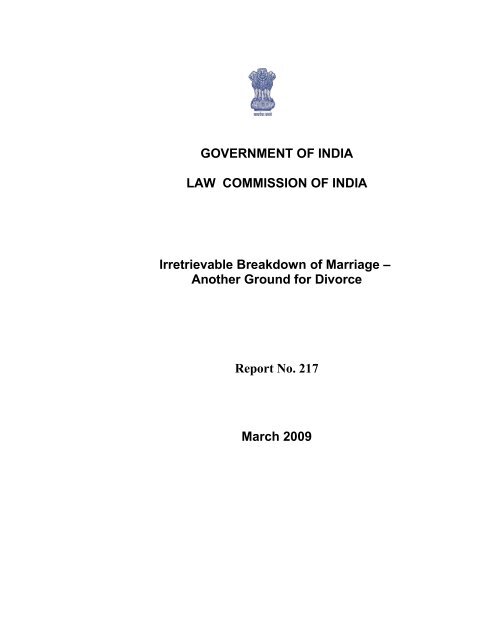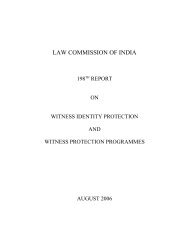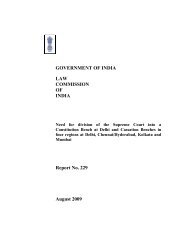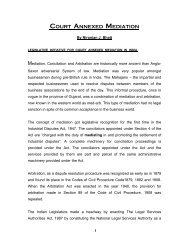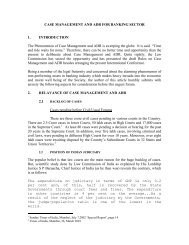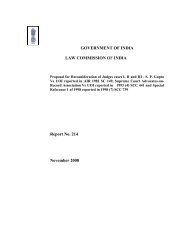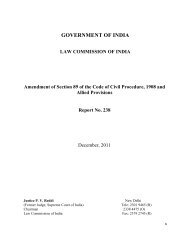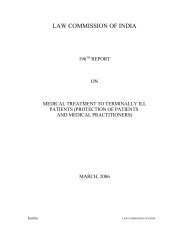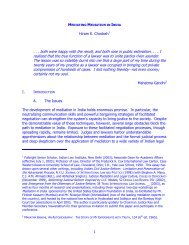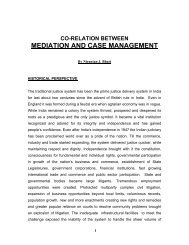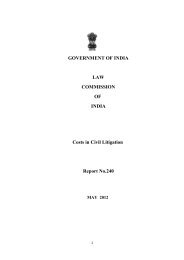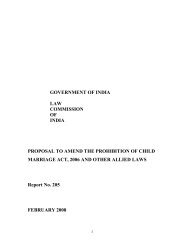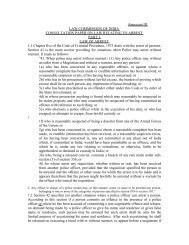217th Report on Irretrievable Breakdown of Marriage - Law ...
217th Report on Irretrievable Breakdown of Marriage - Law ...
217th Report on Irretrievable Breakdown of Marriage - Law ...
Create successful ePaper yourself
Turn your PDF publications into a flip-book with our unique Google optimized e-Paper software.
LAW COMMISSION OF INDIA(REPORT NO. 217)<strong>Irretrievable</strong> <strong>Breakdown</strong> <strong>of</strong> <strong>Marriage</strong> –Another Ground for DivorceForwarded to the Uni<strong>on</strong> Minister for <strong>Law</strong> andJustice, Ministry <strong>of</strong> <strong>Law</strong> and Justice, Government <strong>of</strong>India by Dr. Justice AR. Lakshmanan, Chairman,<strong>Law</strong> Commissi<strong>on</strong> <strong>of</strong> India, <strong>on</strong> the 30th day <strong>of</strong>March, 2009.2
The 18 th <strong>Law</strong> Commissi<strong>on</strong> was c<strong>on</strong>stituted for aperiod <strong>of</strong> three years from 1 st September, 2006 byOrder No. A.45012/1/2006-Admn.III (LA) dated the16 th October, 2006, issued by the Government <strong>of</strong>India, Ministry <strong>of</strong> <strong>Law</strong> and Justice, Department <strong>of</strong>Legal Affairs, New Delhi.The <strong>Law</strong> Commissi<strong>on</strong> c<strong>on</strong>sists <strong>of</strong> the Chairman, theMember-Secretary, <strong>on</strong>e full-time Member and sevenpart-time Members.ChairmanH<strong>on</strong>’ble Dr. Justice AR. LakshmananMember-SecretaryDr. Brahm A. AgrawalFull-time MemberPr<strong>of</strong>. Dr. Tahir MahmoodPart-time MembersDr. (Mrs.) Devinder Kumari RahejaDr. K. N. Chandrasekharan PillaiPr<strong>of</strong>. (Mrs.) Lakshmi JambholkarSmt. Kirti SinghShri Justice I. VenkatanarayanaShri O.P. SharmaDr. (Mrs.) Shyamlha Pappu3
D.O. No. 6(3)/155/2009-LC (LS) 30th March, 2009Dear Dr. Bhardwaj Ji,Subject: <strong>Irretrievable</strong> <strong>Breakdown</strong> <strong>of</strong> <strong>Marriage</strong> –Another Ground for DivorceI am forwarding herewith the 217 thCommissi<strong>on</strong> <strong>of</strong> India <strong>on</strong> the above subject.<str<strong>on</strong>g>Report</str<strong>on</strong>g> <strong>of</strong> the <strong>Law</strong>Secti<strong>on</strong> 13 <strong>of</strong> the Hindu <strong>Marriage</strong> Act, 1955 provides groundsfor presentati<strong>on</strong> <strong>of</strong> a petiti<strong>on</strong> for divorce. Secti<strong>on</strong> 27 <strong>of</strong> the Special<strong>Marriage</strong> Act, 1954 similarly provides grounds for grant <strong>of</strong> divorce inthe case <strong>of</strong> a marriage solemnized under the Act. However, the saidActs do not provide “irretrievable breakdown <strong>of</strong> marriage” as aground for divorce. The <strong>Law</strong> Commissi<strong>on</strong> <strong>of</strong> India in its 71 st <str<strong>on</strong>g>Report</str<strong>on</strong>g>titled “The Hindu <strong>Marriage</strong> Act, 1955 - <strong>Irretrievable</strong> <strong>Breakdown</strong> <strong>of</strong><strong>Marriage</strong> as a Ground <strong>of</strong> Divorce” recommended amendments inthe Hindu <strong>Marriage</strong> Act to make irretrievable breakdown <strong>of</strong> marriageas a new ground for granting divorce am<strong>on</strong>g the Hindus. Recently,the Supreme Court also in Naveen Kohli v. Neelu Kohli (AIR 2006 SC1675) recommended to the Uni<strong>on</strong> <strong>of</strong> India to seriously c<strong>on</strong>siderbringing an amendment in the Hindu <strong>Marriage</strong> Act, 1955 to6
quarrels must be weighed from that point <strong>of</strong> view in determiningwhat c<strong>on</strong>stitutes cruelty in each particular case and alwayskeeping in view the physical and mental c<strong>on</strong>diti<strong>on</strong>s <strong>of</strong> theparties, their character and social status. A too technical andhypersensitive approach would be counter-productive to theinstituti<strong>on</strong> <strong>of</strong> marriage. The Courts do not have to deal withideal husbands and ideal wives. It has to deal with particularman and woman before it. 11.3 In Naveen Kohli v. Neelu Kohli 2 the Supreme Courtrecommended to the Uni<strong>on</strong> <strong>of</strong> India to seriously c<strong>on</strong>sider bringing anamendment in the Hindu <strong>Marriage</strong> Act, 1955 to incorporateirretrievable breakdown <strong>of</strong> marriage as a ground for divorce in thefollowing words:“Before we part with this case, <strong>on</strong> the c<strong>on</strong>siderati<strong>on</strong> <strong>of</strong> thetotality <strong>of</strong> facts, this Court would like to recommend the Uni<strong>on</strong><strong>of</strong> India to seriously c<strong>on</strong>sider bringing an amendment in theHindu <strong>Marriage</strong> Act, 1955 to incorporate irretrievablebreakdown <strong>of</strong> marriage as a ground for the grant <strong>of</strong> divorce. Acopy <strong>of</strong> this judgment be sent to the Secretary, Ministry <strong>of</strong> <strong>Law</strong>& Justice, Department <strong>of</strong> Legal Affairs, Government <strong>of</strong> India fortaking appropriate steps” 31.4 Earlier, in Ms. Jorden Diengdeh v. S. S. Chopra 4 the SupremeCourt observed:1Mayne’s Treatise <strong>on</strong> Hindu <strong>Law</strong> & Usage (16 th Ed.) Revised by Justice Ranganath Misra (New Delhi:Bharat <strong>Law</strong> House, 2008), page 292.2AIR 2006 SC 1675.3Ibid., para 96.4AIR 1985 SC 935.10
“It appears to be necessary to introduce irretrievablebreakdown <strong>of</strong> marriage and mutual c<strong>on</strong>sent as grounds <strong>of</strong>divorce in all cases.…We suggest that the time has come forthe interventi<strong>on</strong> <strong>of</strong> the legislature in those matters to provide fora uniform code <strong>of</strong> marriage and divorce and to provide by lawfor a way out <strong>of</strong> the unhappy situati<strong>on</strong> in which couples like thepresent have found themselves.” 51.5 It is pertinent to notice that the <strong>Law</strong> Commissi<strong>on</strong> <strong>of</strong> India hasalready submitted a very comprehensive 71 st <str<strong>on</strong>g>Report</str<strong>on</strong>g> <strong>on</strong> irretrievablebreakdown <strong>of</strong> marriage as a ground <strong>of</strong> divorce. The matter had beentaken up by the Commissi<strong>on</strong> as a result <strong>of</strong> a reference made by theGovernment <strong>of</strong> India. The <strong>Law</strong> Commissi<strong>on</strong> under the Chairmanship<strong>of</strong> Shri Justice H. R. Khanna presented its <str<strong>on</strong>g>Report</str<strong>on</strong>g> <strong>on</strong> April 7, 1978.The <str<strong>on</strong>g>Report</str<strong>on</strong>g> c<strong>on</strong>sidered the suggesti<strong>on</strong> and analyzed the same inextenso. Before embarking up<strong>on</strong> further acti<strong>on</strong> <strong>on</strong> the suggesti<strong>on</strong> thatirretrievable breakdown <strong>of</strong> marriage should be made as a ground fordivorce, the <strong>Law</strong> Commissi<strong>on</strong> c<strong>on</strong>sidered it appropriate to inviteviews <strong>on</strong> the matter by issuing a brief questi<strong>on</strong>naire. TheCommissi<strong>on</strong> in its 71 st <str<strong>on</strong>g>Report</str<strong>on</strong>g> have accepted in principle irretrievablebreakdown <strong>of</strong> marriage as a ground <strong>of</strong> divorce and also examined thequesti<strong>on</strong> as to how exactly to incorporate it into the Act and als<strong>of</strong>urther examined the questi<strong>on</strong> whether the introducti<strong>on</strong> <strong>of</strong> such aground should be coupled with any safeguards. The Commissi<strong>on</strong>also in Chapter II <strong>of</strong> the said <str<strong>on</strong>g>Report</str<strong>on</strong>g> c<strong>on</strong>sidered present law underthe Hindu <strong>Marriage</strong> Act, merits and demerits <strong>of</strong> the theory <strong>of</strong>irretrievable breakdown <strong>of</strong> marriage in Chapter IV and retenti<strong>on</strong> <strong>of</strong>5Ibid., para 7.11
other grounds <strong>of</strong> divorce in Chapter V. In Chapter VI the Commissi<strong>on</strong>also c<strong>on</strong>sidered the requirement <strong>of</strong> living apart and also suggestedmany safeguards like welfare <strong>of</strong> children, hardship andrecommended amendments to Secti<strong>on</strong>s 21A, 23(1)(a) and alsorecommended inserti<strong>on</strong> <strong>of</strong> new secti<strong>on</strong>s 13C, 13D and 13E.1.6 In the light <strong>of</strong> the above, the <strong>Law</strong> Commissi<strong>on</strong> suo motu tookup the study <strong>on</strong> the subject.II.JUDICIAL VIEW/SUGGESTIONS2.1 A law <strong>of</strong> divorce based mainly <strong>on</strong> fault is inadequate to dealwith a broken marriage. Under the fault theory, guilt has to beproved; divorce Courts are presented with c<strong>on</strong>crete instances <strong>of</strong>human behaviour as bring the instituti<strong>on</strong> <strong>of</strong> marriage into disrepute. 6Once the marriage has broken down bey<strong>on</strong>d repair, it would beunrealistic for the law not to take notice <strong>of</strong> that fact, and it would beharmful to society and injurious to the interest <strong>of</strong> the parties. Wherethere has been a l<strong>on</strong>g period <strong>of</strong> c<strong>on</strong>tinuous separati<strong>on</strong>, it may fairlybe surmised that the matrim<strong>on</strong>ial b<strong>on</strong>d is bey<strong>on</strong>d repair. Themarriage becomes a ficti<strong>on</strong>, though supported by a legal tie, byrefusing to sever that tie, the law in such cases does not serve thesanctity <strong>of</strong> marriage; <strong>on</strong> the c<strong>on</strong>trary, it shows scant regard for thefeelings and emoti<strong>on</strong>s <strong>of</strong> the parties. Public interest demands not<strong>on</strong>ly that the married status should, as l<strong>on</strong>g as possible, andwhenever possible, be maintained, but where a marriage has been671 st <str<strong>on</strong>g>Report</str<strong>on</strong>g> <strong>of</strong> the <strong>Law</strong> Commissi<strong>on</strong> <strong>of</strong> India.12
wrecked bey<strong>on</strong>d the hope <strong>of</strong> salvage, public interest lies in therecogniti<strong>on</strong> <strong>of</strong> that fact. Since there is no acceptable way in which aspouse can be compelled to resume life with the c<strong>on</strong>sort, nothing isgained by trying to keep the parties tied for ever to a marriage that infact has ceased to exist. Human life has a short span and situati<strong>on</strong>scausing misery cannot be allowed to c<strong>on</strong>tinue indefinitely. A halt hasto be called at some stage. <strong>Law</strong> cannot turn a blind eye to suchsituati<strong>on</strong>s, nor can it decline to give adequate resp<strong>on</strong>se to thenecessities arising therefrom. 7 The Supreme Court in Naveen Kohlivs. Neelu Kohli 8 recommended to the Uni<strong>on</strong> <strong>of</strong> India to seriouslyc<strong>on</strong>sider bringing an amendment in the Hindu <strong>Marriage</strong> Act, 1955 toincorporate irretrievable breakdown <strong>of</strong> marriage as a ground fordivorce.2.2 The irretrievable breakdown <strong>of</strong> marriage is not a ground for divorceby itself. But while scrutinizing the evidence <strong>on</strong> record to determinewhether the grounds <strong>on</strong> which divorce is sought are made out, thecircumstances can be taken into c<strong>on</strong>siderati<strong>on</strong>. No divorce can be granted<strong>on</strong> the ground <strong>of</strong> irretrievable breakdown <strong>of</strong> marriage if the party seekingdivorce <strong>on</strong> this ground is himself or herself at fault. The decree <strong>of</strong> divorce<strong>on</strong> the ground that the marriage has irretrievably broken down can begranted in those cases where both the parties have levelled such allegati<strong>on</strong>sagainst each other that the marriage appears to be practically dead and theparties cannot live together. The power <strong>of</strong> the Court to grant divorce <strong>on</strong> theground <strong>of</strong> irretrievable breakdown <strong>of</strong> marriage should be exercised with7Supra note 1, pages 292 – 293.8Supra note 2.13
much care and cauti<strong>on</strong> in excepti<strong>on</strong>al circumstances <strong>on</strong>ly in the interest <strong>of</strong>both the parties. 92.3 In Geeta Mullick v. Brojo Gopal Mullick 10 the Calcutta HighCourt held:“In our c<strong>on</strong>sidered opini<strong>on</strong>, the marriage between the partiescan not be dissolved by the trial Court or even by the HighCourt <strong>on</strong>ly <strong>on</strong> the ground <strong>of</strong> marriage having been irretrievablybroken down, in the absence <strong>of</strong> <strong>on</strong>e or more grounds asc<strong>on</strong>templated under secti<strong>on</strong> 13(1) <strong>of</strong> the Hindu <strong>Marriage</strong> Act,1955.” 112.4 The c<strong>on</strong>cept <strong>of</strong> irretrievable breakdown <strong>of</strong> marriage cannot beused as magic formula to obtain a decree for divorce where groundsfor divorce are not proved.2.5 In V. Bhagat v. D. Bhagat 12 the Supreme Court held :“<strong>Irretrievable</strong> breakdown <strong>of</strong> the marriage is not a groundfor divorce by itself. But while scrutinizing the evidence <strong>on</strong>record to determine whether the ground(s) alleged ismade out and in determining the relief to be granted, thesaid circumstance can certainly be borne in mind.” 139Supra note 1, page 293.10AIR 2003 Cal. 321.11Ibid., para 7.12AIR 1994 SC 710.13Ibid., para 23.14
2.6 The Calcutta High Court in Tapan Kumar Chakraborty v.Jyotsna Chakraborty 14 held that in a petiti<strong>on</strong> for divorce <strong>on</strong> aground as menti<strong>on</strong>ed in the Hindu <strong>Marriage</strong> Act or the Special<strong>Marriage</strong> Act, court cannot grant divorce <strong>on</strong> the mere ground <strong>of</strong>irretrievable breakdown <strong>of</strong> marriage.2.7 In Kanchan Devi v. Pramod Kumar Mittal 15 , however, theSupreme Court held:“…the marriage between the appellant and the resp<strong>on</strong>dent hasirretrievably broken down and that there was no possibility <strong>of</strong>rec<strong>on</strong>ciliati<strong>on</strong>, we in exercise <strong>of</strong> our powers under Art. 142 <strong>of</strong>the C<strong>on</strong>stituti<strong>on</strong> <strong>of</strong> India hereby direct that the marriagebetween the appellant and the resp<strong>on</strong>dent shall standdissolved by a decree <strong>of</strong> divorce.” 162.8 There is no use <strong>of</strong> keeping two pers<strong>on</strong>s tied by the matrim<strong>on</strong>ialrelati<strong>on</strong>ship when they cannot live peacefully. Where wedlock has becomea deadlock, since parties are living separately, and after marriage the wifehas lived <strong>on</strong>ly for a few m<strong>on</strong>ths in the matrim<strong>on</strong>ial home, wife having madeallegati<strong>on</strong>s <strong>of</strong> cruelty and deserti<strong>on</strong> against the husband and husband havingmade counter-allegati<strong>on</strong>s against her, the court in Krishna vs. Som Nath 17held that marriage is irretrievably broken and it is in the interest <strong>of</strong> justicethat decree <strong>of</strong> divorce be granted so that both the parties can live in peace.When the court finds in facts as well as from talks <strong>of</strong> resettlement orrec<strong>on</strong>ciliati<strong>on</strong> between parties that there was no possibility <strong>of</strong> reuni<strong>on</strong>14AIR 1997 Cal. 134.15AIR 1996 SC 3192.16Ibid., para 6.17(1996) DMC 667 (P&H).15
etween husband and wife and refusal <strong>of</strong> decree <strong>of</strong> divorce would <strong>on</strong>lyprol<strong>on</strong>g the ag<strong>on</strong>ies <strong>of</strong> the spouses, it can dissolve the marriage <strong>on</strong> thisground. 18 Where the husband and the wife are living separately from eachother for the last 19 years and there is no chance <strong>of</strong> settlement between theparties a decree for divorce can be granted. 19 Where there was noc<strong>on</strong>summati<strong>on</strong> <strong>of</strong> marriage, wife being adverse to cohabitati<strong>on</strong>, wifedisobeyed instructi<strong>on</strong>s <strong>of</strong> the court to undergo medical examinati<strong>on</strong> to provethat marriage had not c<strong>on</strong>summated, there was indecent behaviour <strong>of</strong> wife toher in-laws reflecting her mental imbalance, and the parties have been livingseparately for a period <strong>of</strong> 16 years without any serious attempt forrec<strong>on</strong>ciliati<strong>on</strong>, a decree dissolving the marriage would be proper. 202.9 The Supreme Court in Savitri Pandey v. Prem ChandraPandey 21 held that marriage between the parties cannot bedissolved <strong>on</strong>ly <strong>on</strong> the averments made by <strong>on</strong>e <strong>of</strong> the partiesthat as the marriage between them has broken down, no usefulpurpose would be served to keep it alive. The legislature, in itswisdom, despite observati<strong>on</strong> <strong>of</strong> the Supreme Court has notthought it proper to provide for dissoluti<strong>on</strong> <strong>of</strong> the marriage <strong>on</strong>such averments. There may be cases where it is found that asthe marriage has become dead <strong>on</strong> account <strong>of</strong> c<strong>on</strong>tributory acts<strong>of</strong> commissi<strong>on</strong> and omissi<strong>on</strong> <strong>of</strong> the parties, no useful purposewould be served by keeping such marriage alive. The sanctity<strong>of</strong> marriage cannot be left at the whims <strong>of</strong> <strong>on</strong>e <strong>of</strong> the annoyingspouses.18Ashok v. Rupa, 1996 (2) HLR 512 (Guj).19Shankar v. Puspita, AIR 2005 Jhar. 92.20Rita v. Trilokesh, AIR 2007 Gau.122.21AIR 2002 SC 591.16
2.10 In Vinita Saxena v. Pankaj Pandit 22 , the marriage betweenVinita Saxena and her husband Pankaj Pandit was dissolved by anorder <strong>of</strong> the Supreme Court. The marriage between the partieslasted <strong>on</strong>ly for five m<strong>on</strong>ths. Both <strong>of</strong> them were living separately forover 13 years. <strong>Marriage</strong> also was not c<strong>on</strong>summated. Wife filed apetiti<strong>on</strong> for the dissoluti<strong>on</strong> <strong>of</strong> marriage <strong>on</strong> the ground <strong>of</strong> physical andmental cruelty and insanity <strong>on</strong> the part <strong>of</strong> the husband. Trial courthowever dismissed the petiti<strong>on</strong>. High Court also dismissed theappeal despite the failure <strong>of</strong> the husband to appear before the court.Allowing the appeal <strong>of</strong> the wife, a divisi<strong>on</strong> bench <strong>of</strong> the SupremeCourt speaking through Dr. Justice AR. Lakshmanan ( as he thenwas ) held that the orders <strong>of</strong> the courts below had resulted in gravemiscarriage <strong>of</strong> justice to the wife who had been c<strong>on</strong>strained into livingwith a dead relati<strong>on</strong>ship for over 13 years and that the fact situati<strong>on</strong>clearly showed that the husband and wife can never ever stay ashusband and wife and the wife’s stay with the resp<strong>on</strong>dent husbandwould be injurious to her health. Accordingly, a decree <strong>of</strong> divorcewas granted in favour <strong>of</strong> the wife against the husband. The Courtheld as follows:“36. As to what c<strong>on</strong>stitute the required mental cruelty forpurposes <strong>of</strong> the said provisi<strong>on</strong>, will not depend up<strong>on</strong> thenumerical count <strong>of</strong> such incidents or <strong>on</strong>ly <strong>on</strong> the c<strong>on</strong>tinuouscourse <strong>of</strong> such c<strong>on</strong>duct but really go by the intensity, gravityand stigmatic impact <strong>of</strong> it when meted out even <strong>on</strong>ce and thedeleterious effect <strong>of</strong> it <strong>on</strong> the mental attitude, necessary formaintaining a c<strong>on</strong>ducive matrim<strong>on</strong>ial home.22JT 2006 (3) SC 587.17
37. If the taunts, complaints and reproaches are <strong>of</strong> ordinarynature <strong>on</strong>ly, the court perhaps need c<strong>on</strong>sider the furtherquesti<strong>on</strong> as to whether their c<strong>on</strong>tinuance or persistence over aperiod <strong>of</strong> time render, what normally would, otherwise, not beso serious an act to be so injurious and painful as to make thespouse charged with them genuinely and reas<strong>on</strong>ably c<strong>on</strong>cludethat the maintenance <strong>of</strong> matrim<strong>on</strong>ial home is not possible anyl<strong>on</strong>ger.……44. Spouses owe rights and duties each to the other and intheir relati<strong>on</strong>ship they must act reas<strong>on</strong>ably. In every casewhere cruelty exists it is possible to say that the spouse at faulthas been unreas<strong>on</strong>able. The list <strong>of</strong> cruelty, therefore, shouldbe reach <strong>of</strong> the duty to act reas<strong>on</strong>ably, whether in omissi<strong>on</strong> orcommissi<strong>on</strong>, causing injury to health. Such a list avoidsimputing an intenti<strong>on</strong> where in fact n<strong>on</strong>e may exist. Further allsuch matters are foresight, desires, wishes, intenti<strong>on</strong>, motives,percepti<strong>on</strong>, obtuseness, persistence and indifference wouldremain relevant but merely as matter <strong>of</strong> evidence bearing up<strong>on</strong>the requirement to act reas<strong>on</strong>ably or as aggravati<strong>on</strong> <strong>of</strong> thematters charged.….49. Humane aspects which this Court should c<strong>on</strong>sider:- The appellant was 24 years <strong>of</strong> age when she got married.- The marriage lasted for four to five m<strong>on</strong>ths <strong>on</strong>ly when shewas compelled to leave the matrim<strong>on</strong>ial home.18
- The marriage between the parties was not c<strong>on</strong>summated asthe resp<strong>on</strong>dent was not in a positi<strong>on</strong> to fulfil the matrim<strong>on</strong>ialobligati<strong>on</strong>.- The parties have been living separately since 1993. 13years have passed they have never seen each other.- Both the parties have crossed the point <strong>of</strong> no return.- A workable soluti<strong>on</strong> is certainly not possible.- Parties at this stage cannot rec<strong>on</strong>cile themselves and livetogether forgetting their past as a bad dream.- Parties have been fighting the legal battle from the year1994.- The situati<strong>on</strong> between the parties would lead to a irrefutablec<strong>on</strong>clusi<strong>on</strong> that the appellant and the resp<strong>on</strong>dent can neverever stay as husband and wife and the wife’s stay with theresp<strong>on</strong>dent is injurious to her health.- The appellant has d<strong>on</strong>e her Ph.D. The resp<strong>on</strong>dent,according to the appellant, is not gainfully employedanywhere.- As a matter <strong>of</strong> fact, after leaving his depositi<strong>on</strong> incompleteduring the trial, the resp<strong>on</strong>dent till date has neither appearedbefore the trial court nor before the High Court.50. The facts and circumstances <strong>of</strong> the case as well as allaspects pertain to humanity and life would give sufficientcogent reas<strong>on</strong>s for us to allow the appeal and relieve theappellant from shackles and chain <strong>of</strong> the resp<strong>on</strong>dent and lether live her own life, if nothing less but like a human being.”19
2.11 In Samar Ghosh vs Jaya Ghosh 23 the Supreme Court referredto the 71 st <str<strong>on</strong>g>Report</str<strong>on</strong>g> <strong>of</strong> the <strong>Law</strong> Commissi<strong>on</strong> <strong>of</strong> India <strong>on</strong> "<strong>Irretrievable</strong><strong>Breakdown</strong> <strong>of</strong> <strong>Marriage</strong>" with approval as follows:“90. We have examined and referred to the cases from the variouscountries. We find str<strong>on</strong>g basic similarity in adjudicati<strong>on</strong> <strong>of</strong> casesrelating to mental cruelty in matrim<strong>on</strong>ial matters. Now, we deem itappropriate to deal with the 71st <str<strong>on</strong>g>Report</str<strong>on</strong>g> <strong>of</strong> the <strong>Law</strong> Commissi<strong>on</strong> <strong>of</strong>India <strong>on</strong> "<strong>Irretrievable</strong> <strong>Breakdown</strong> <strong>of</strong> <strong>Marriage</strong>".91. The 71 st <str<strong>on</strong>g>Report</str<strong>on</strong>g> <strong>of</strong> the <strong>Law</strong> Commissi<strong>on</strong> <strong>of</strong> India briefly dealt withthe c<strong>on</strong>cept <strong>of</strong> irretrievable breakdown <strong>of</strong> marriage. This <str<strong>on</strong>g>Report</str<strong>on</strong>g> wassubmitted to the Government <strong>on</strong> 7th April, 1978. In this <str<strong>on</strong>g>Report</str<strong>on</strong>g>, it ismenti<strong>on</strong>ed that during last 20 years or so, and now it would be around50 years, a very important questi<strong>on</strong> has engaged the attenti<strong>on</strong> <strong>of</strong>lawyers, social scientists and men <strong>of</strong> affairs, should the grant <strong>of</strong>divorce be based <strong>on</strong> the fault <strong>of</strong> the party, or should it be based <strong>on</strong> thebreakdown <strong>of</strong> the marriage? The former is known as the matrim<strong>on</strong>ial<strong>of</strong>fence theory or fault theory. The latter has come to be known as thebreakdown theory. It would be relevant to recapitulaterecommendati<strong>on</strong> <strong>of</strong> the said <str<strong>on</strong>g>Report</str<strong>on</strong>g>.92. In the <str<strong>on</strong>g>Report</str<strong>on</strong>g>, it is menti<strong>on</strong>ed that the germ <strong>of</strong> the breakdowntheory, so far as Comm<strong>on</strong>wealth countries are c<strong>on</strong>cerned, may befound in the legislative and judicial developments during a muchearlier period. The (New Zealand) Divorce and Matrim<strong>on</strong>ial CausesAmendment Act, 1920, included for the first time the provisi<strong>on</strong> that aseparati<strong>on</strong> agreement for three years or more was a ground formaking a petiti<strong>on</strong> to the court for divorce and the court was given adiscreti<strong>on</strong> (without guidelines) whether to grant the divorce or not.The discreti<strong>on</strong> c<strong>on</strong>ferred by this statute was exercised in a caseLodder v. Lodder (1921 New Zealand <strong>Law</strong> <str<strong>on</strong>g>Report</str<strong>on</strong>g>s 786). Salm<strong>on</strong>d J.,in a passage which has now become classic, enunciated thebreakdown principle in these words:23(2007) 4 SCC 511.20
‘The Legislature must, I think, be taken to have intendedthat separati<strong>on</strong> for three years is to be accepted by thisCourt, as prima facie a good ground for divorce. Whenthe matrim<strong>on</strong>ial relati<strong>on</strong> has for that period ceased toexist de facto, it should, unless there are special reas<strong>on</strong>sto the c<strong>on</strong>trary, cease to exist de jure also. In general, itis not in the interests <strong>of</strong> the parties or in the interest <strong>of</strong> thepublic that a man and woman should remain boundtogether as husband and wife in law when for a lengthyperiod they have ceased to be such in fact. In the case <strong>of</strong>such a separati<strong>on</strong> the essential purposes <strong>of</strong> marriagehave been frustrated, and its further c<strong>on</strong>tinuance is ingeneral not merely useless but mischievous.’93. In the said <str<strong>on</strong>g>Report</str<strong>on</strong>g>, it is menti<strong>on</strong>ed that restricting the ground <strong>of</strong>divorce to a particular <strong>of</strong>fence or matrim<strong>on</strong>ial disability, causesinjustice in those cases where the situati<strong>on</strong> is such that although n<strong>on</strong>e<strong>of</strong> the parties is at fault, or the fault is <strong>of</strong> such a nature that the partiesto the marriage do not want to divulge it, yet such a situati<strong>on</strong> hasarisen in which the marriage cannot survive. The marriage has all theexternal appearances <strong>of</strong> marriage, but n<strong>on</strong>e in reality. As is <strong>of</strong>ten putpithily, the marriage is merely a shell out <strong>of</strong> which the substance isg<strong>on</strong>e. In such circumstances, it is stated, there is hardly any utility inmaintaining the marriage as a facade, when the emoti<strong>on</strong>al and otherb<strong>on</strong>ds which are <strong>of</strong> the essence <strong>of</strong> marriage have disappeared.94. It is also menti<strong>on</strong>ed in the <str<strong>on</strong>g>Report</str<strong>on</strong>g> that in case the marriage hasceased to exist in substance and in reality, there is no reas<strong>on</strong> fordenying divorce, then the parties al<strong>on</strong>e can decide whether theirmutual relati<strong>on</strong>ship provides the fulfilment which they seek. Divorceshould be seen as a soluti<strong>on</strong> and an escape route out <strong>of</strong> a difficultsituati<strong>on</strong>. Such divorce is unc<strong>on</strong>cerned with the wr<strong>on</strong>gs <strong>of</strong> the past,but is c<strong>on</strong>cerned with bringing the parties and the children to termswith the new situati<strong>on</strong> and developments by working out the mostsatisfactory basis up<strong>on</strong> which they may regulate their relati<strong>on</strong>ship inthe changed circumstances.95. Once the parties have separated and the separati<strong>on</strong> has c<strong>on</strong>tinuedfor a sufficient length <strong>of</strong> time and <strong>on</strong>e <strong>of</strong> them has presented a21
petiti<strong>on</strong> for divorce, it can well be presumed that the marriage hasbroken down. The court, no doubt, should seriously make anendeavour to rec<strong>on</strong>cile the parties; yet, if it is found that thebreakdown is irreparable, then divorce should not be withheld. Thec<strong>on</strong>sequences <strong>of</strong> preservati<strong>on</strong> in law <strong>of</strong> the unworkable marriagewhich has l<strong>on</strong>g ceased to be effective are bound to be a source <strong>of</strong>greater misery for the parties.”2.12 Similarly, in Sanghamitra Ghosh vs Kajal Kumar Ghosh 24 theSupreme Court while referring to its earlier decisi<strong>on</strong> in Ashok Hurra vRupa Bipin Zaveri 25 , also reproduced some excerpts from theaforesaid 71 st <str<strong>on</strong>g>Report</str<strong>on</strong>g> <strong>of</strong> the <strong>Law</strong> Commissi<strong>on</strong>.2.13 As stated earlier, the recent decisi<strong>on</strong> <strong>of</strong> the Apex Court in thecase <strong>of</strong> Naveen Kohli vs. Neelu Kohli 26 fully establishes the need forimmediate amendment <strong>of</strong> the Hindu <strong>Marriage</strong> Act to incorporate‘irretrievable breakdown <strong>of</strong> marriage’ as a ground for grant <strong>of</strong> divorce.The Court in that case was dealing with a case where the partieswere living separately for ten years. There were, during this period,many proceedings between the parties, mostly by the wife.Allegati<strong>on</strong>s <strong>of</strong> misc<strong>on</strong>duct were made <strong>on</strong> both sides, maintenancewas demanded and paid and the proceedings lingered <strong>on</strong> causingdeep anxiety and frustrati<strong>on</strong> to both sides. The husband filed fordivorce <strong>on</strong> the ground available – cruelty. The Trial Court grantedhim relief but the High Court turned down the divorce petiti<strong>on</strong> <strong>on</strong> theground that the c<strong>on</strong>duct <strong>of</strong> the wife did not fall within the parameters<strong>of</strong> ‘cruelty’ as defined in various judgments. The husband was back24(2007) 2 SCC 220.25(1997) 4 SCC 226.26Supra note 2.22
to square <strong>on</strong>e. On appeal, the Supreme Court granted him relief.This was a classic case <strong>of</strong> c<strong>on</strong>sent being withheld by a spouse justfor harassing the other spouse. The Court recommended to theUni<strong>on</strong> <strong>of</strong> India to seriously c<strong>on</strong>sider bringing an amendment in theHindu <strong>Marriage</strong> Act, 1955 to incorporate ‘irretrievable breakdown <strong>of</strong>marriage’ as a ground for grant <strong>of</strong> divorce.2.14 It would also be in the fitness <strong>of</strong> things that the Special<strong>Marriage</strong> Act, 1954, which deals with the civil marriages, is alsoc<strong>on</strong>sidered for an amendment <strong>on</strong> similar lines.III.RECOMMENDATION3.1 It is, therefore, suggested that immediate acti<strong>on</strong> be taken tointroduce an amendment in the Hindu <strong>Marriage</strong> Act, 1955 and theSpecial <strong>Marriage</strong> Act, 1954 for inclusi<strong>on</strong> <strong>of</strong> ‘irretrievable breakdown<strong>of</strong> marriage’ as another ground for grant <strong>of</strong> divorce.23
3.2 The amendment may also provide that the court beforegranting a decree for divorce <strong>on</strong> the ground that the marriage hasirretrievably broken down should also examine whether adequatefinancial arrangements have been made for the parties and children.3.3 We recommend accordingly.(Dr. Justice AR. Lakshmanan)Chairman(Pr<strong>of</strong>. Dr. Tahir Mahmood) (Dr. Brahm A. Agrawal)Member Member-Secretary24


